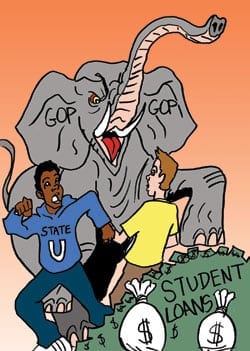
Investing in America’s future
With little fanfare, the student loan program was revamped as part of the much-publicized health care reform package. The measure eliminated the involvement of commercial banks in the student loan business, thus wiping out billions of dollars of potential profit. The federal government will now make loans directly.
Republicans were unanimously opposed to the measure in both the House and the Senate. The vote was 56 to 43 in the Senate and 220 to 207 in the House.
Under the old financial aid program, the government provided the loan funds and then guaranteed any losses that the banks might suffer. The banks kept any interest and fees received in the process of repayment.
Lamar Alexander, a Republican senator from Tennessee and a former U.S. secretary of education, decried the Democratic policy as “another Washington takeover.” The Republican perspective seems to support the use of taxpayers’ funds in the marketplace only to assure corporate profits.
The reform measure includes automatic increases in the size of Pell grants to reflect an increase in inflation. However, the increase to $5,900 in 2019-20 from $5,550 in the next school year hardly keeps up with the growth of tuition in public and private colleges.
The legislation does provide a boon for students who have incurred substantial debt. After July 1, 2014, students will be required to pay no more than 10 percent of their income to retire new loans. Now the standard is 15 percent. Those who maintain regular payments for 20 years will now have the balance of their loans forgiven. That is five years sooner than the current 25.
President Obama understands that a highly educated population is essential for the United States to remain an economic leader of the world. Both China and India have populations that are each roughly four times larger than the United States’. Asians have developed an ability in recent years to excel in science and technology. This makes them highly competitive in the technological global economy.
Because of the Republican opposition and heavy lobbying against President Obama’s education agenda, he decided to avoid a potential filibuster in the Senate by attaching student loan reform to the health care bill and taking it to the Senate under reconciliation rules. This requires a majority vote only on matters of fiscal significance. As a consequence, the Obama education agenda had to be watered down.
The administration cut $8 billion for early childhood education and $12 billion for community colleges. However, $2.55 billion for historically black colleges and universities survived. The new proposal also rescued Pell grants from severe budget cuts.
Republicans seem to have had a vision of the swashbuckling entrepreneur who, with vision and courage, risks everything on the vagaries of the market and wins. However, the current business model puts all risk on the taxpayer, while all profit goes to the businessman. With intensive education so necessary for the nation’s survival, it is un-American to permit such an unsupportable point of view to impede the revamping of the financing of American education.
President Obama correctly places major importance on the expansion of educational opportunity in America.






